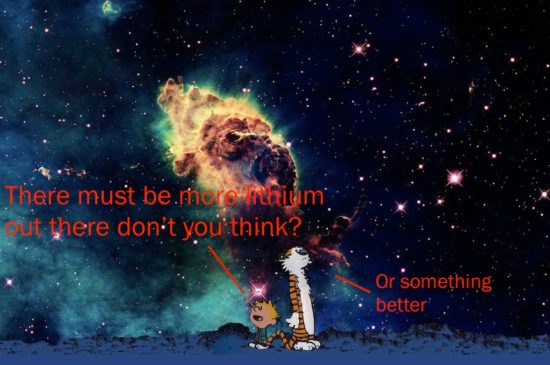by Wallace Wyss –
National Public Radio (NPR) has stirred up a hornet’s nest with a documentary on the critical shortage of materials in the US needed to make batteries for EVs. This whole fiasco started when automakers began talking about making EVs. Detroit’s Big Three dithered until Tesla came out of nowhere and adroitly showed how it could be done. Now many of the world’s automakers are saying they will be 100% EV by 2030.
The zero emissions/low carbon lobby was feeling pretty good about the switchover to EVs proceeding at a fast pace, conveying the impression that electric car owners are the saintly ones amongst us, making it possible for, in the US anyway, an emissions-free world, a veritable heaven of fresh air, thriving vegetable gardens, no downside.
Except the dirty little secret is that, so far, electric cars need batteries. And the batteries use these materials: lithium, cobalt, manganese, nickel and graphite.
So what’s the problem? US automakers just go out and place orders for those materials, right? Except that on that list, the US only has lithium in quantity. Oh, Idaho has cobalt but that’s on US Forest Service land, so, sorry, no mining permits there. So for all the others the automakers are rushing to Russia for manganese and nickel. But wait a minute, isn’t the US supposed to cutting back on buying from Russia because of their invasion of Ukraine?
OK, let’s take Chile. They have one of the materials but do we know if they use child labor or what the working conditions are? And if we buy battery materials from China, what about their enslavement of the Uyghur people in the mines? In short, the clean air/zero emissions/carbon neutral advocates want it both ways–they want EVs but don’t want to hear about who we as a nation have to deal with to buy the battery materials to make EVs.
The solution: less precious materials
The Union of Concerned Scientists said in a recent paper,
The materials used in the lithium-ion battery cathode vary. Until recently, most of the popular EVs contained a battery with cobalt and nickel because it enables them to have a long range in a compact size. Tesla and Ford are now transitioning towards a chemistry without cobalt for their lower range EVs, called lithium-iron phosphate (LFP). Nickel and cobalt are expensive materials and have some of the highest associated environmental and social impacts. Lessening the use of these materials is overall beneficial, but it also reduces the battery’s worth to recyclers.
In an article on the website EuroNews they said,
Researchers are working on new battery alternatives that would replace lithium and cobalt (another harmful metal) with less toxic and more easily accessible materials. As reserves of lithium and cobalt will not meet future demand, suggested elements to focus on instead are iron and silicon. Unlike lithium-ion batteries, iron flow batteries are also cheaper to manufacture, renewable energy veteran Rich Hossfeld told Bloomberg recently, in an article entitled “Iron battery breakthrough could eat lithium’s lunch”
In a perfectly logical conclusion the article quoted Gleb Yushin, a professor at the School of Materials and Engineering at Georgia Institute of Technology, saying, “We call on materials scientists, engineers and funding agencies to prioritise the research and development of electrodes based on abundant elements.”
The transition to lower cost domestically available materials needs to happen quick. Before the environmentalists go so far as banning new ICE cars, we as a nation need to quit condoning EV battery materials bought from the Third World at a human cost we-don’t want to know about. We buy them from Russia, they buy more weapons to invade Ukraine.
And yet US automakers have made this huge commitment to go gung-ho on EVs, without planning in advance where they would source the battery materials (except for Tesla who bought a mine or two for one of the materials).
So EV owners could get what they want, by 2030–an EV driving nation–but as far as how they got the battery materials, we’re not supposed to ask because environmentalists don’t want it generally known that the deeper you dig literally and figuratively, the more evident it will be that, with some of the present preferred materials, they have blood on their hands…with Russia and China, it’s war and oppression, with South Africa and Chile, you could equate some of the materials to “blood diamonds,” recalling that phrase that was popular when it became known the cruel conditions that existed at the diamond mines.
Let us know what you think in the Comments.
THE AUTHOR Wallace Wyss comments on cars weekly on Autotalk a show broadcast from KUCR FM, Riverside.
Calvin & Hobbs by Bill Watterson (text by Mike Gulett).





Thank you for the great piece Wallace. These are the same concerns I have about the rush into EV’s, without the details being fully worked out yet, mainly in terms of battery technology and sourcing of the needed materials from countries not necessarily aligned with our goals and needs. I think we learned something very important during Covid that we cannot rely on foreign sources for what is needed here in the U.S., namely virtually complete reliance on China, which is not particularly our friend. In any event, this wholesale rush into EV production is fraught with issues and the car makers are all on board with it and it surprises me that more are not taking a stand with the government on this looming fiasco.
Wallace, excellent piece. It’s about time folks woke up to the fact that EVs are NOT the panacea the environmentalists claim. Yes, they have a place. But Toyota has revealed a multi-fuel source strategy to accommodate situations around the world. EVs are only one solution.
A greater issue, however, is the availability of electric power. The grid can’t really handle it now with the brown outs that California experiences. But there are many downsides to the “green” power generation technologies being pushed on us. There is down time for the big windmills and solar panels (especially in the Midwest). They are valid, yes. They do help supplement power generation. But that’s the best they can do. We have no real national plan for developing the infrastructure to go all electric in everything. It is a hodge podge of competing ideas that don’t make a “whole.”
Heaven help us!
Yep. So many disconnects between talking heads and the folks that know what it takes to make things happen.
It is refreshing to see people openly and honestly speaking about an issue that so far, is being rammed down our throats. Even at the rate that technology moves today, as we have read in the article above, there is no clean “light switch” solution that will get us to all electric by 2030. Not enough raw materials, forced relationships with bad actors, and lets also mention the current supply chain issues that have the auto and truck business tied up in knots. It is interesting to see what a company like Cummins is doing with Fuel Agnostic engines. Investing big into engine platforms that can run on different fuels to include hydrogen, CNG, propane, gasoline, and diesel, while they are also developing electric drivelines with their most recent purchase, Meritor. Read about the new engines here:
https://www.truckinginfo.com/10192432/cummins-unveils-x10-fuel-agnostic-engine#.Y-uWKUeg2Pg.mailto
Batteries still need to be charged, and except for some renewables like solar panels and wind turbines, there is no power-generating infrastructure that will be able to power all the electric vehicles that are going to be on the road by 2030. I am not even talking about the charging infrastructure, I am talking about the power-generating infrastructure. I see no power companies rushing to build new power plants, and you already have rolling blankouts throughout the state of California as it is. Until there is a national plan, perhaps a public/private plan to generate all the power required, this is going to be an industry going through a lot of growing pains, indeed. Renewables are not reliable, steady, or constant enough (wind and sunlight do not run 24/7), and there has to be a public/private consortium to build new plants to generate all the required power for all these new electric cars. Glenn in Brooklyn, NY.
Wake up! There is no free lunch! Electric power doesn’t pour down out of the sky into power plants we build to charge batteries. Power plants are fueled by many sources that would give a Tesla driver nightmares. 40% comes from natural gas, only 1% from petroleum, but 19% from coal and 20% from nuclear. Not too many coal plants or nukes being built these days. The remaining 20% are renewables but 7.3% of that is hydroelectric and no one wants big lakes anymore. As some have said renewables aren’t reliable. We could dig up the oceans of coal and leave a big hole where West Virginia and Kentucky were and charge all the EVs in California. But who would really be happy?
As a professional engineer who’s worked in the energy industry for over 15 years, I can tell you that there is no way to get energy without some form of environmental footprint. The more important question to ask is “what’s the best way to minimize our footprint?”
Yes, EVs are an imperfect solution, but when compared to the alternative, they are an improvement. First, they require roughly 1/3 the energy to do the same thing as an internal combustion engine. Second, even with a U.S. grid still heavily reliant on fossil fuels, their life cycle carbon is roughly half that of an ICE. Finally, while raw material extraction can be problematic and needs more oversight, what about the social and political issues that come from burning fossil fuels. Russia couldn’t even wage a war on Ukraine if not for fossil fuels.
So while I think there are fair criticisms of EVs, they must be weighed against the current alternative that’s at the core of the climate crisis. Of course if you’re really concerned about your environmental footprint, you could just walk or ride a bike.